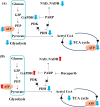Role of Exogenous Pyruvate in Maintaining Adenosine Triphosphate Production under High-Glucose Conditions through PARP-Dependent Glycolysis and PARP-Independent Tricarboxylic Acid Cycle
- PMID: 39456870
- PMCID: PMC11508270
- DOI: 10.3390/ijms252011089
Role of Exogenous Pyruvate in Maintaining Adenosine Triphosphate Production under High-Glucose Conditions through PARP-Dependent Glycolysis and PARP-Independent Tricarboxylic Acid Cycle
Abstract
Pyruvate serves as a key metabolite in energy production and as an anti-oxidant. In our previous study, exogenous pyruvate starvation under high-glucose conditions induced IMS32 Schwann cell death because of the reduced glycolysis-tricarboxylic acid (TCA) cycle flux and adenosine triphosphate (ATP) production. Thus, this study focused on poly-(ADP-ribose) polymerase (PARP) to investigate the detailed molecular mechanism of cell death. Rucaparib, a PARP inhibitor, protected Schwann cells against cell death and decreased glycolysis but not against an impaired TCA cycle under high-glucose conditions in the absence of pyruvate. Under such conditions, reduced pyruvate dehydrogenase (PDH) activity and glycolytic and mitochondrial ATP production were observed but not oxidative phosphorylation or the electric transfer chain. In addition, rucaparib supplementation restored glycolytic ATP production but not PDH activity and mitochondrial ATP production. No differences in the increased activity of caspase 3/7 and the localization of apoptosis-inducing factor were found among the experimental conditions. These results indicate that Schwann cells undergo necrosis rather than apoptosis or parthanatos under the aforementioned conditions. Exogenous pyruvate plays a pivotal role in maintaining the flux in PARP-dependent glycolysis and the PARP-independent TCA cycle in Schwann cells under high-glucose conditions.
Keywords: PARP; Schwann cells; adenosine triphosphate depletion; cell death; exogenous pyruvate; glycolysis; high-glucose; tricarboxylic acid cycle.
Conflict of interest statement
The authors declare that the research was conducted in the absence of any commercial or financial relationships that could be construed as a potential conflict of interest.
Figures







Similar articles
-
Role of pyruvate in maintaining cell viability and energy production under high-glucose conditions.Sci Rep. 2021 Sep 23;11(1):18910. doi: 10.1038/s41598-021-98082-w. Sci Rep. 2021. PMID: 34556698 Free PMC article.
-
Pyruvate improves recovery after PARP-1-associated energy failure induced by oxidative stress in neonatal rat cerebrocortical slices.J Cereb Blood Flow Metab. 2007 Feb;27(2):304-15. doi: 10.1038/sj.jcbfm.9600335. Epub 2006 May 24. J Cereb Blood Flow Metab. 2007. PMID: 16736046
-
Exogenous pyruvate accelerates glycolysis and promotes capacitation in human spermatozoa.Hum Reprod. 2011 Dec;26(12):3249-63. doi: 10.1093/humrep/der317. Epub 2011 Sep 23. Hum Reprod. 2011. PMID: 21946930 Free PMC article.
-
Poly(ADP-ribose) Polymerase (PARP) and PARP Inhibitors: Mechanisms of Action and Role in Cardiovascular Disorders.Cardiovasc Toxicol. 2018 Dec;18(6):493-506. doi: 10.1007/s12012-018-9462-2. Cardiovasc Toxicol. 2018. PMID: 29968072 Review.
-
Therapeutic Targeting of the Pyruvate Dehydrogenase Complex/Pyruvate Dehydrogenase Kinase (PDC/PDK) Axis in Cancer.J Natl Cancer Inst. 2017 Nov 1;109(11). doi: 10.1093/jnci/djx071. J Natl Cancer Inst. 2017. PMID: 29059435 Review.
Cited by
-
Blood-Based Lateral-Flow Immunoassays Dipstick Test for Damaged Mitochondrial Electron Transport Chain in Pyruvate Treated Rats with Combined Blast Exposure and Hemorrhagic Shock.J Clin Med. 2025 Jan 24;14(3):754. doi: 10.3390/jcm14030754. J Clin Med. 2025. PMID: 39941423 Free PMC article.
-
Epalrestat Alleviates Reactive Oxygen Species and Endoplasmic Reticulum Stress by Maintaining Glycosylation in IMS32 Schwann Cells Under Exposure to Galactosemic Conditions.Int J Mol Sci. 2025 Feb 12;26(4):1529. doi: 10.3390/ijms26041529. Int J Mol Sci. 2025. PMID: 40003995 Free PMC article.
-
Immortalized Schwann cell lines as useful tools for pathogenesis-based therapeutic approaches to diabetic peripheral neuropathy.Front Endocrinol (Lausanne). 2025 Jan 21;15:1531209. doi: 10.3389/fendo.2024.1531209. eCollection 2024. Front Endocrinol (Lausanne). 2025. PMID: 39906036 Free PMC article. Review.
-
Pyruvate Administration Restores Impaired Nociception by Enhancing Neurite Outgrowth in Streptozotocin-Induced Diabetic Mice.Int J Mol Sci. 2025 May 13;26(10):4666. doi: 10.3390/ijms26104666. Int J Mol Sci. 2025. PMID: 40429808 Free PMC article.
-
PARP (Poly ADP-ribose Polymerase) Family in Health and Disease.MedComm (2020). 2025 Sep 1;6(9):e70314. doi: 10.1002/mco2.70314. eCollection 2025 Sep. MedComm (2020). 2025. PMID: 40904702 Free PMC article. Review.
References
-
- Kamiya H., Himeno T., Watarai A., Baba M., Nishimura R., Tajima N., Nakamura J. Prevalence and characteristics of diabetic symmetric sensorimotor polyneuropathy in Japanese patients with type 2 diabetes: The Japan Diabetes Complication and its Prevention Prospective study (JDCP study 10) J. Diabetes Investig. 2024;15:247–253. doi: 10.1111/jdi.14105. - DOI - PMC - PubMed
-
- Akamine T., Takaku S., Suzuki M., Niimi N., Yako H., Matoba K., Kawanami D., Utsunomiya K., Nishimura R., Sango K. Glycolaldehyde induces sensory neuron death through activation of the c-Jun N-terminal kinase and p-38 MAP kinase pathways. Histochem. Cell Biol. 2020;153:111–119. doi: 10.1007/s00418-019-01830-3. - DOI - PubMed
-
- Niimi N., Yako H., Takaku S., Kato H., Matsumoto T., Nishito Y., Watabe K., Ogasawara S., Mizukami H., Yagihashi S., et al. A spontaneously immortalized Schwann cell line from aldose reductase-deficient mice as a useful tool for studying polyol pathway and aldehyde metabolism. J. Neurochem. 2018;144:710–722. doi: 10.1111/jnc.14277. - DOI - PubMed
-
- Kato A., Tatsumi Y., Yako H., Sango K., Himeno T., Kondo M., Kato Y., Kamiya H., Nakamura J., Kato K. Recurrent short-term hypoglycemia and hyperglycemia induce apoptosis and oxidative stress via the ER stress response in immortalized adult mouse Schwann (IMS32) cells. Neurosci. Res. 2019;147:26–32. doi: 10.1016/j.neures.2018.11.004. - DOI - PubMed
MeSH terms
Substances
Grants and funding
LinkOut - more resources
Full Text Sources
Research Materials

